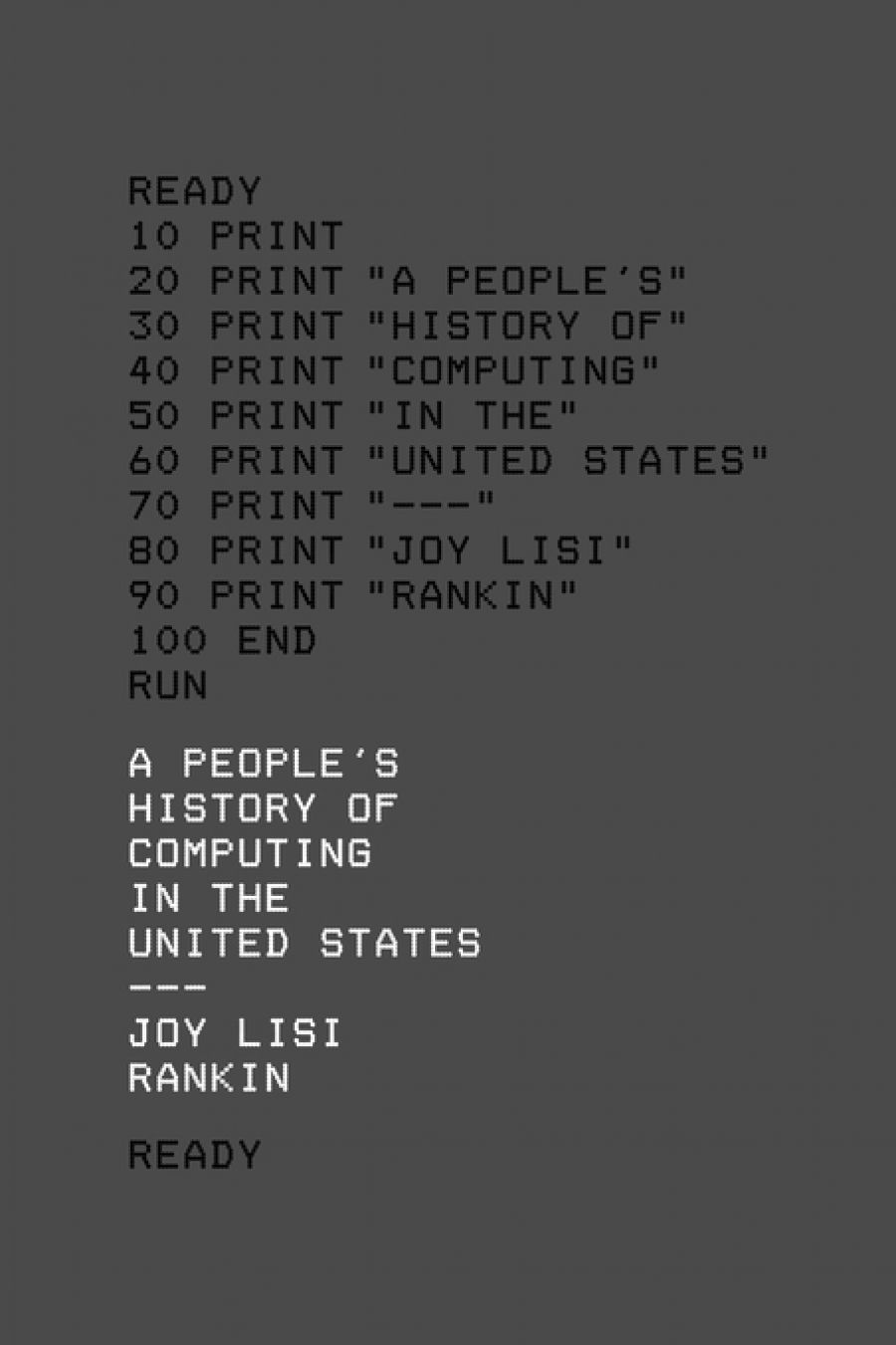
- Free Article: No
- Contents Category: History
- Custom Article Title: Josh Specht reviews <em>A People’s History of Computing in the United States</em> by Joy Lisi Rankin
- Review Article: Yes
- Online Only: No
- Custom Highlight Text:
According to most accounts, the history of computing is a triumph of enterprise. This story starts in the 1950s and 1960s with commercial mainframe computers that, one stack of punch-cards at a time, assumed business tasks ranging from managing airline reservations to calculating betting odds ...
- Book 1 Title: A People’s History of Computing in the United States
- Book 1 Biblio: Harvard University Press (Footprint), $64.99 hb, 336 pp, 9780674970977
Joy Lisi Rankin’s A People’s History of Computing in the United States is the story of teachers, students, and programming evangelists. Rankin’s bottom-up history focuses on an important early technology known as ‘time-sharing’: individual users worked at terminals connected to a central mainframe that divided its time among them. These systems privileged accessibility over efficiency as users executed relatively simple programs rather than the resource-intensive tasks mainframes performed in a business setting. Advocates for this technology viewed these systems as a digital commons in which users shared a resource akin to a public utility. Time-sharing networks both broadened the base of the computer literate as well as pioneered the user-friendliness necessary to make the computer a mass technology. In telling this story, Rankin buries what she calls the ‘Silicon Valley Myth’, which draws a line from the mainframe to personal computing through the garages of entrepreneur–geniuses like Gates and Jobs.
 Joy Lisi RankinThough Rankin’s book celebrates the largely forgotten world of time-sharing, she notes that it was not a utopia. Chapter Two, ‘Making a Macho Computing Culture’, traces how Dartmouth College’s computing world became intertwined with the school’s football culture, and how the computer labs quickly became male-dominated spaces, even if women had been (and remained) important to its development. Older sexist assumptions – such as the characterisation of women’s work as either insignificant or maternal – were imported into an emerging culture that went on to develop its own kinds of stereotypes, such as the figure of the woman who ‘can’t take a joke’ on the computer network.
Joy Lisi RankinThough Rankin’s book celebrates the largely forgotten world of time-sharing, she notes that it was not a utopia. Chapter Two, ‘Making a Macho Computing Culture’, traces how Dartmouth College’s computing world became intertwined with the school’s football culture, and how the computer labs quickly became male-dominated spaces, even if women had been (and remained) important to its development. Older sexist assumptions – such as the characterisation of women’s work as either insignificant or maternal – were imported into an emerging culture that went on to develop its own kinds of stereotypes, such as the figure of the woman who ‘can’t take a joke’ on the computer network.
On a happier note, the importance of games and human interaction is a theme throughout. Chapter Five, ‘How The Oregon Trail Began in Minnesota’, explores the computer game The Oregon Trail, in which seemingly every American school child from about 1980 to 2000 steered a group of settlers in a fun, if highly sanitised, recreation of the settling the American West. Working on a time-sharing network linking Minnesota high schools, several teachers developed the game in the early 1970s and it would become a key driver of early digital literacy. Games got children excited about computers and helped transform computing from an acquired skill into a native one.
Rankin similarly notes that communication drove the spread of computing as much as machine efficiency. About ARPANET, the internet’s precursor, Rankin observes that because it ‘had been created to connect and share the valuable resources of computers, most people did not immediately consider the possibilities of sharing human resources. Rather, users valued ARPANET only after they created an unplanned use for it: electronic mail. ARPANET’s ‘smash hit’ was its role as a ‘communications medium’. The implication here is that though some of the big developments in computing were driven by concrete business or defence needs, the popularisation and personalisation of the computer was about people trying to interact with each other and even have fun.
A People’s History of Computing in the United States provides enough evidence to bury the Silicon Valley Myth. That is not to say that the story told in the myth is not important, but rather that it is incomplete. Nevertheless, it is seriously unlikely that the Silicon Valley myth is going anywhere, particularly in the public imagination. This is because of the political and ideological work it does. A story of innovation and enterprise underpins a belief that our greatest achievements are exclusively the work of business and the profit motive. And the myth of the lone genius – usually male – helps elide the contributions made by women as well as non-élite actors. I would have been curious to hear more about Rankin’s thoughts on the power of the Silicon Valley myth and the possibilities to which her alternative account could be put.
Rankin’s study is a major revision of our understanding of the history of computing as well as our assumptions about the relationship between the general public and technological development. The book is also a delight to read. In one memorable passage, she describes how a computer program works, intertwining the BASIC programming-language commands with a prose explanation of each step. It is clear enough for a luddite, but for me it brought back delightful memories of sitting in my elementary school computer lab and bolting upright with excitement as a computer, one I had programmed myself, displayed the grand proclamation: ‘Hello, World!’


Comments powered by CComment